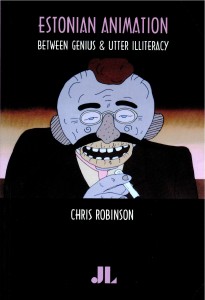
Near the beginning of this thoroughly wonderful book, the author, being a self-described 100% Canadian hockey playing lad from the Ottawa Valley, reflects with some anxiety on how and why he ended up spending six years in the prime of his life researching and writing a book on Estonian Animation.
The how is easy enough to explain. As a film school graduate and recently minted director of the Ottawa International Animation Festival (one of the "Big 4" on the animation world circuit), Chris Robinson knew little or nothing about Estonia or Estonian animation until a fateful encounter with filmmakers Priit Pärn and Janno Põldma at a festival in Stuttgart in 1996.
One thing led to another and he soon discovered that unbeknownst to almost everyone, including the vast majority of Estonians at home or abroad, in the world of International Animation, tiny little unassuming Estonia is a kick-ass First-World Superpower (yes, really) — owner of a flamboyantly distinctive, controversial and influential Style that emerged, in defiance of all odds and logic, from a diverse group of artists and their works (20 artists and ca. 250 works are listed in a "Select Filmography" at the end of the book) over the past 50 years.
It is an amazing and improbable story that was begging to be told, but until Robinson came along no part of it had been written up in any language. Nor had anyone thought to preserve the original works, many of which had been made on unstable soviet film stocks with distribution controlled by now-defunct soviet central agencies. It was also complicated by some substantial disagreements between certain of the principal actors. (These antagonisms are fairly described in the book, clearly enough for this reviewer to comment that: "Estos will be Estos...")
Fortunately, as the book and private conversations with some of the filmmakers (my cousin is profiled in "The Next Wave" chapter) make clear, Robinson was exactly the right person at exactly the right time. His personal energy, enthusiasm and perseverance, not to mention the fact that he was a foreigner with no partisan axe to grind, broke down many doors and even inspired the locals to start working on their own neglected back-stories and archives.
The book itself is a joy to read. Robinson uses a predominately first-person prose style wherein the principals, their collaborators, the author and sometimes his guides and translators (ex-Torontonian Peeter Tammisto is amongst the latter and contributes a vignette concerning Elmar [Sr.]) seem to take turns addressing the reader directly. The effect is vivid and engaging — an awful lot of "hard" information is conveyed without ever getting academic or otherwise turgidly obtuse.
The story itself is organized around two broad narrative arcs — one devoted to Nukufilm, which concentrated on puppet and cut-out animation, and the other for Joonisfilm, which concentrates on drawn, or "cel" animation. Each arc features a series of biographical portraits arranged in a roughly chronological order that follows and details the productions of each studio through their principal filmmakers and their collaborators.
Nukufilm came first and began almost by accident in 1957 as a sort of after-hours experiment by staffers at the exclusively live-action Tallinnfilm and continues to this day as an independent, private studio. Between 1957 and 1975 Nukufilm had only two directors: Elbert Tuganov and Heino Pars, but they produced a great many films of various types and degrees of merit, involving hundreds of designers, artists, writers, actors, composers, musicians, voice actors, (a who’s who of post-war Estonian arts and letters — Arvo Pärt, Leonard Lapin, Aili Vint, Jüri Arrak, Lepo Sumera, Paul-Eerik Rummo, amongst many others) technicians and inevitably, bureaucrats (some of whom emerge as heroes). Especially during the 1960's and early 1970's Nukufilm was an exciting point of convergence — and outlet — for artistic currents flowing from the partial thaw of the Khrushchev spring.
Joonisfilm was founded in 1972 by Rein Raamat, who had earlier worked as a designer at Nukufilm and together with others chafed under the two director system. A controversial character, Raamat built on the Nukufilm infrastructure but steered Joonisfilm in resolutely modern and almost exclusively grown-up "art" oriented directions. New styles of art together with a fresh generation of artists, writers and musicians were drawn into Joonisfilm projects. The incomparable Priit Pärn, together with Mati Kütt, Heiki Ernits and Janno Põldma, amongst others, got their starts in Joonisfilm and participate in its successful continuation as an independent studio to this day, although Raamat himself was squeezed out long ago.
Robinson is especially persistent — and good — at eliciting detailed descriptions of the mundane transactional realities of artistic creativity in soviet-era Estonia from the various protagonists. It is clear that he is no fan of communism, but has no scores of his own to settle. Instead, he has done an excellent job of portraying a practical world that is thoroughly exotic and strange to those of us who were brought up west of the iron curtain, even as it was obvious and unremarkable to those living on the other side.
Parts of the book are laugh-out-loud funny — for example, the film Suur Tõll (Joonisfilm, 1979, dir. Rein Raamat, art design Jüri Arrak) was based on a folk-tale about the great Saaremaa hero who defends his people against foreign invaders. Folk-tales were considered politically "safe" but given the nationalistic sub-text, in this case the censors were being very strict. A close-up scene of the hero’s eye was criticised for representing the banned national flag, although it was finally allowed to pass when Arrak pointed out that his own eyes were blue, black and white. The censors remained adamant that the enemies could not be represented by the colour red, so they were re-drawn in lilac. Unfortunately, or otherwise, the blue dye in the soviet film stock of the time was so unstable that it faded out entirely after two showings, leaving the evil enemies bright red after all — a major crisis for which no-one could be blamed. Various attempts were made to show the film projected through a blue filter, but these were abandoned as impractical and the film was withdrawn from showings within the Soviet Union. It continued to be shown abroad, however, and won a prize at the Ottawa festival in 1982.
Estonian animation art was often exhibited in the west (usually by Moscow bureaucrats, rather than the filmmakers) to show how "advanced" and "modern" soviet society was, even as the self-same films were banned or severely restricted at home. Robinson’s narrative repeatedly highlights various permutations of this almost schizophrenic state of affairs: as the most "western" of the soviet republics Estonia was subjected to especially harsh and vigilant political repression on the one hand, even as it was allowed and even encouraged to act and serve as a sort of quarantined vestibule for the safe landing of western influences. There is a sense that, troublesome as they were, Estonian animators were tolerated and, to some extent, indulged by soviet authorities, even if the reasons for this remain obscure.
Surprisingly, animation continues to flourish in Estonia while it crumbled with communism everywhere else in the former eastern bloc. The stresses and strains of the transition period were fresh on everyone’s mind — and produced some extraordinary films — while this book was being written and one of my few criticisms of the first edition (published 2003 in Estonia and not widely distributed, even in Estonia) revolved about a somewhat tentative and incomplete feel to its "current developments" coverage.
That criticism and the half dozen proofreading slips, that the former Law Review editor in me couldn’t help flagging, have all been corrected in the second, slightly revised "international" edition, published in November, 2006. So as to avoid not offering any criticism (and thus risk being drummed out of the book reviewers guild on this, my maiden voyage), I will state for the record that I preferred the original title and the original format —slightly smaller, slightly less glossy paper — which somehow met my eye and fit my hand better than the new.
There are also places where Robinson’s unbridled admiration for Estonians and things Estonian may start seeming a little over the top, even for an Estonian chauvinist such as myself. Then again, who could possibly argue with an author who starts the last paragraph of his book off as follows:
"In an age when indigenous cultures are increasingly being replaced by a unifyingly sterile, homogenous corporate culture, Estonia’s amazing cultural vitality in music, art, literature, film and animation is astonishing..."
Despite these minuscule quibbles, this remains a rave review: Despite or possibly because of its somewhat esoteric subject matter, this is easily amongst the very best books ever published in English on or about anything Estonian.
In the end, Chris Robinson never does manage to figure out why he spent six years of his life researching and writing a book on Estonian Animation, but you get the idea that he is glad he did. You will be too, once you read the book.
***
This book review doesn’t really touch upon a major subject of the book — the films themselves. The main reason for this is that apart from some of the Lotte movies and a handful of my cousin’s films, I had never actually seen any of the works discussed in the book. The book is great on its own: you do not have to be a cinematíste or animatsioniando to enjoy it from cover to cover.
When I finally finished my review of the first edition of this book, I got in touch with Chris Robinson in Ottawa to see if he had any copies available for sale in Canada or whether interested readers and possibly Estore would have to hunt these down via Eesti.
I also wanted to find out whether there was any way to actually see any of the films in Canada — in response to my repeated suggestions that Eesti Joonisfilm should put together a sample DVD for sale over here, my cousin Ülo had made some vague references to Chris having a collection of some sort or holding North American distribution rights.
Happily the news from Ottawa was excellent on both fronts — the second edition of the book is being published in November 2006 and will be available through regular bookstores everywhere (including Estore) — just in time for Christmas.
As for the films, why yes, he does have a "massive" collection of Estonian animation — all of which is available for viewing pretty well "anytime" at the Ottawa International Animation Festival’s Animation Resource Centre, (2 Daly Ave. Suite 120, check the website for hours, etc).
Better yet, for anyone outside the Ottawa - Hull area, the Festival has four VHS tapes of Estonian Animation (two of Pärn, one of Kütt and a sampler of recent Joonisfilm works) available for sale via the website : start at http://ottawa.awn.com and click down to merchandise and then videos.
I ordered, received and was well satisfied. Powerful stuff, some of it powerfully strange. Certainly not everyone’s BigGulp of DietCoke, but WOW. Pärn’s Hotel E, in particular, is still buzzing around in my head.
Best of all, Chris is willing to do a guided screening here in Toronto, possibly even sign some books, you know, if anyone were to ask. We agreed that late January or early February might be a good time for it and left it at that for now — anyone interested in helping set something up can contact me through the usual channels.




















